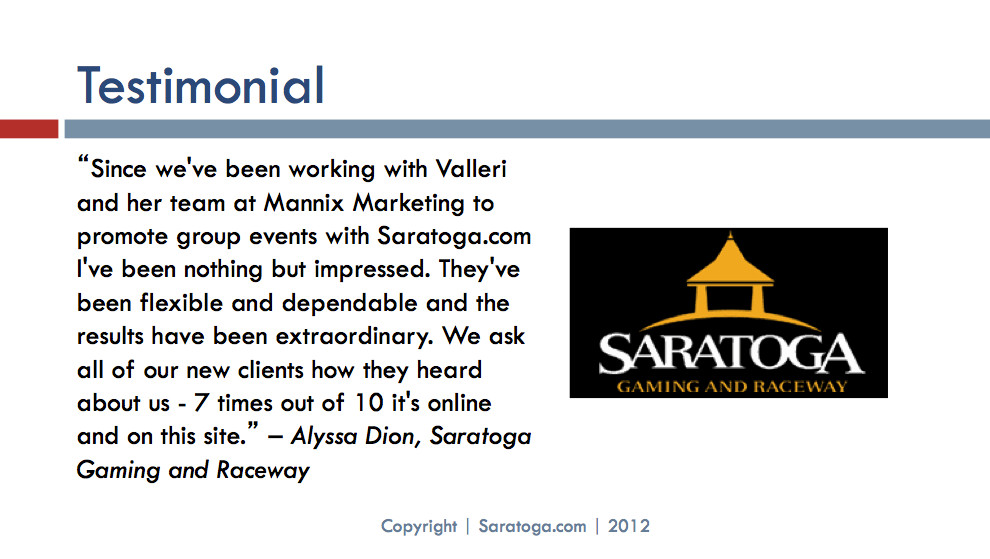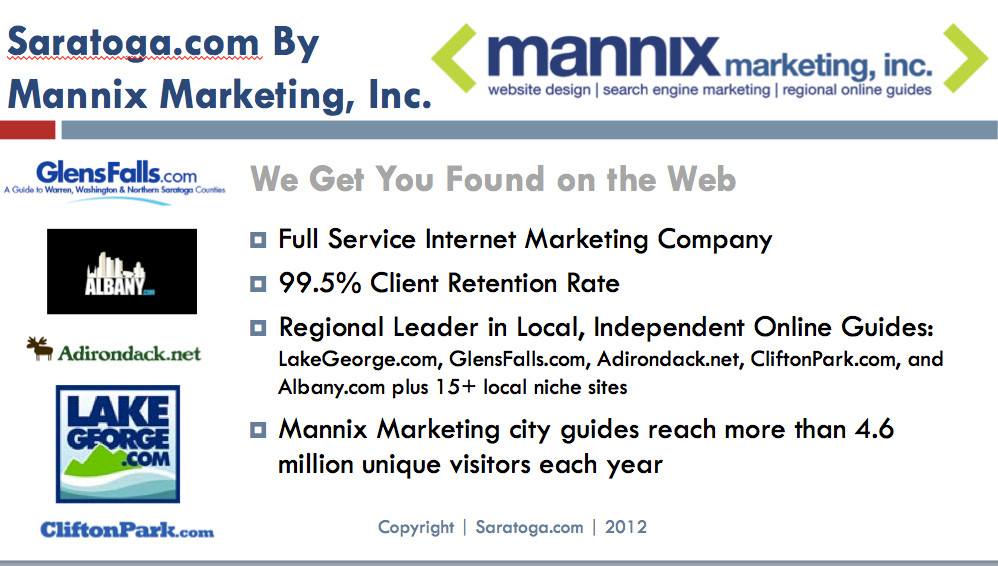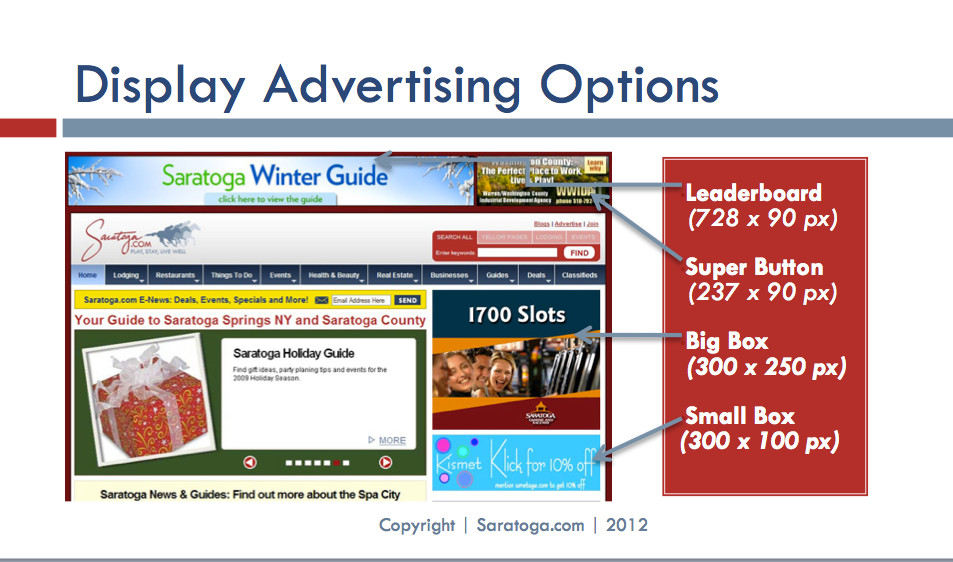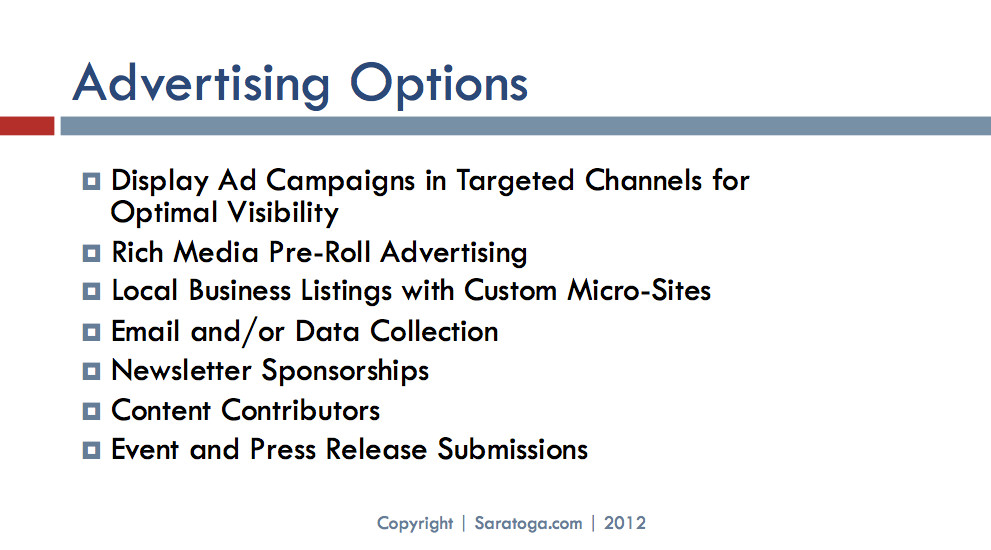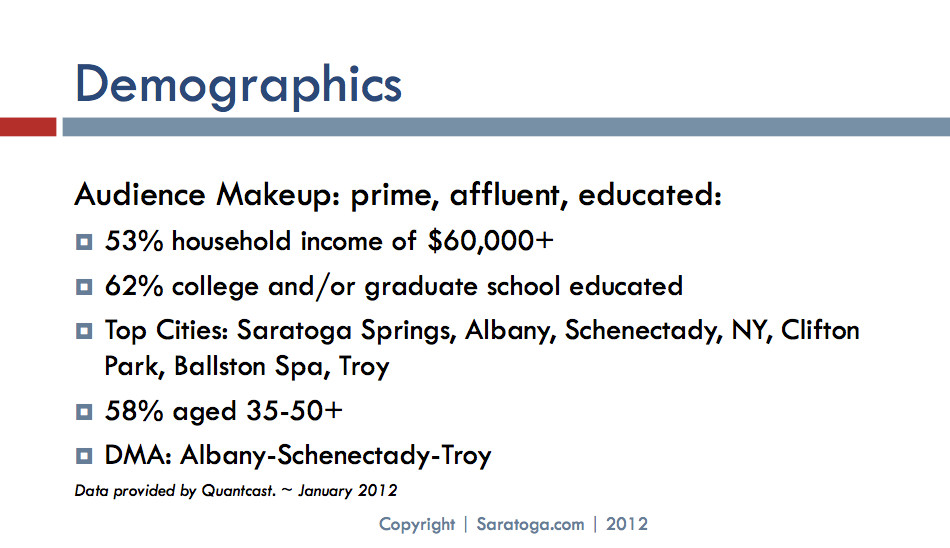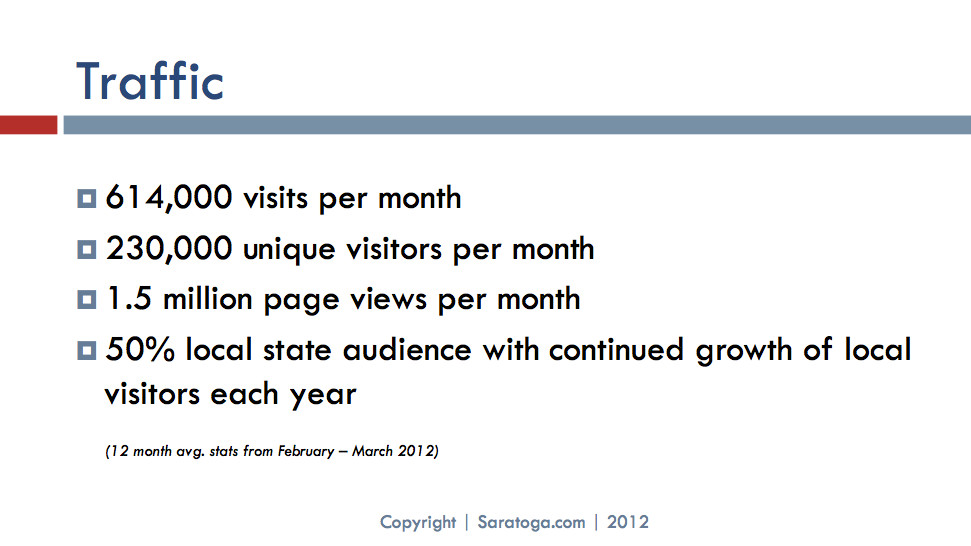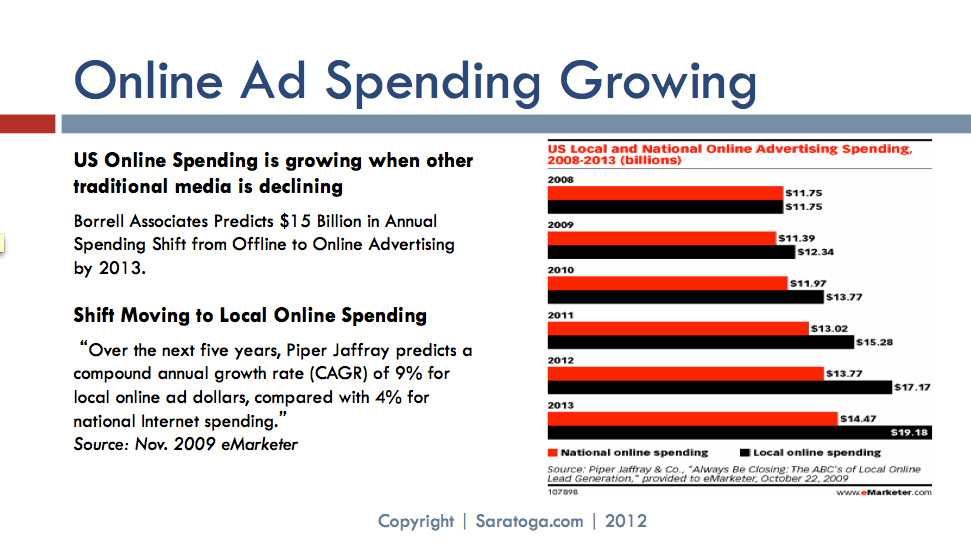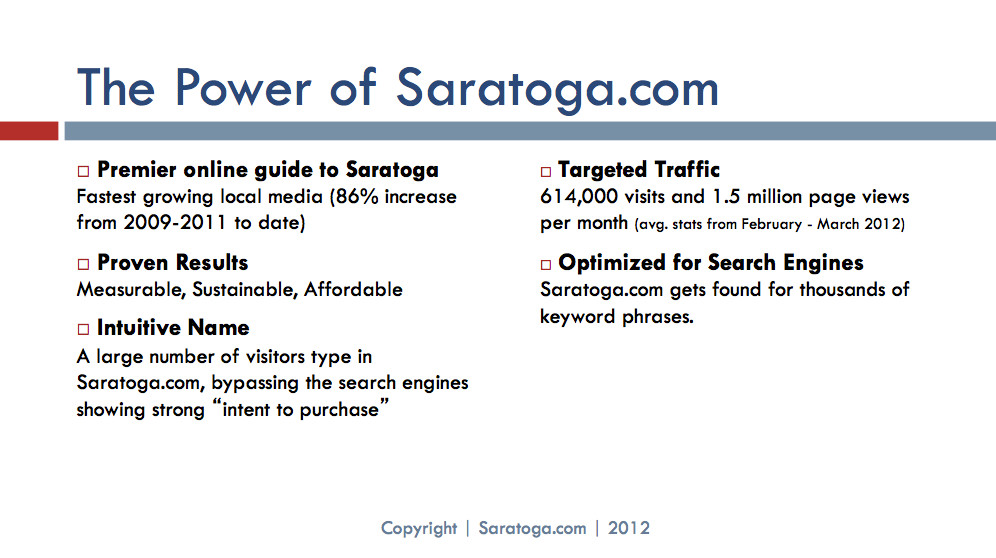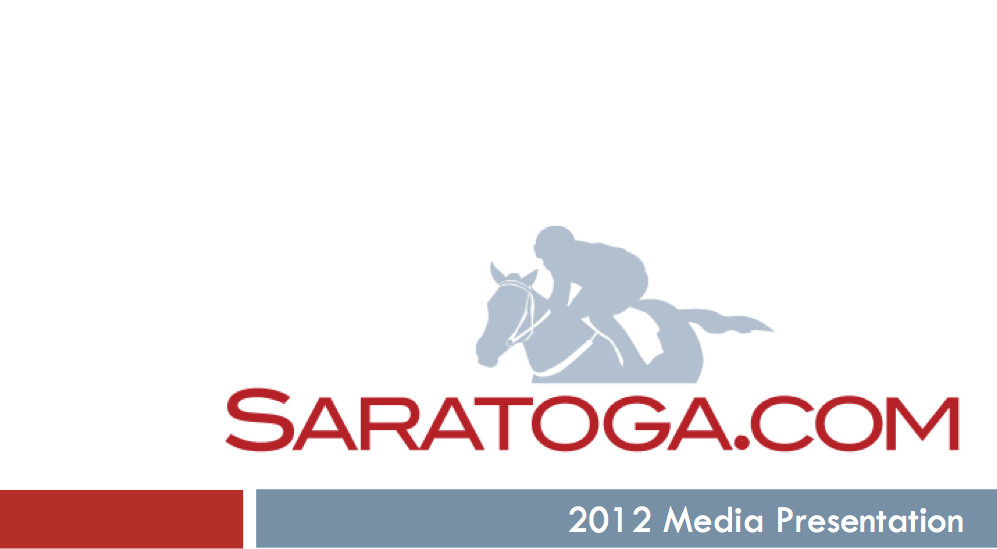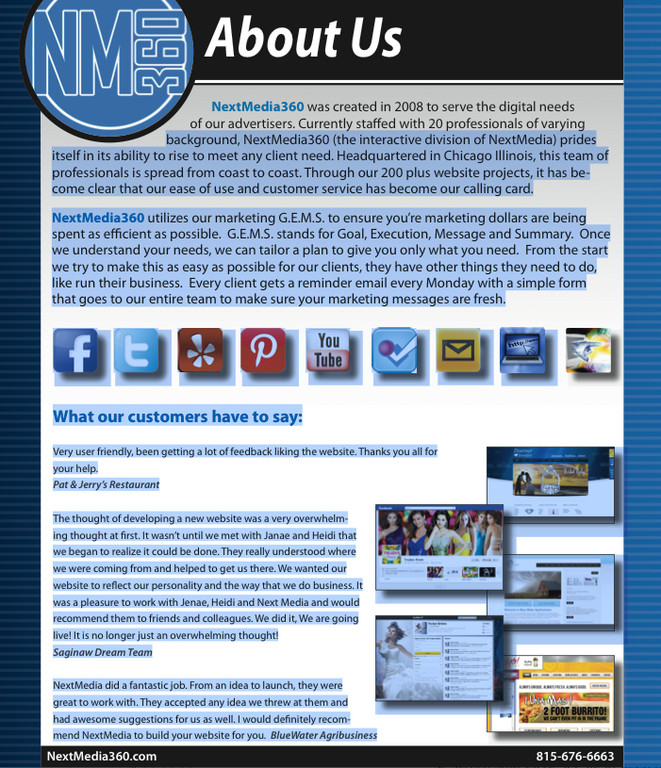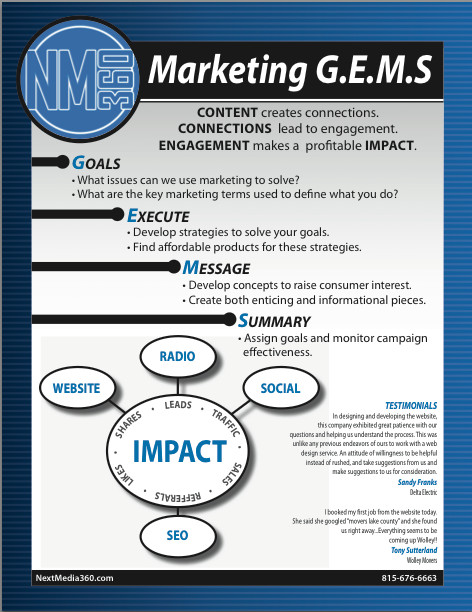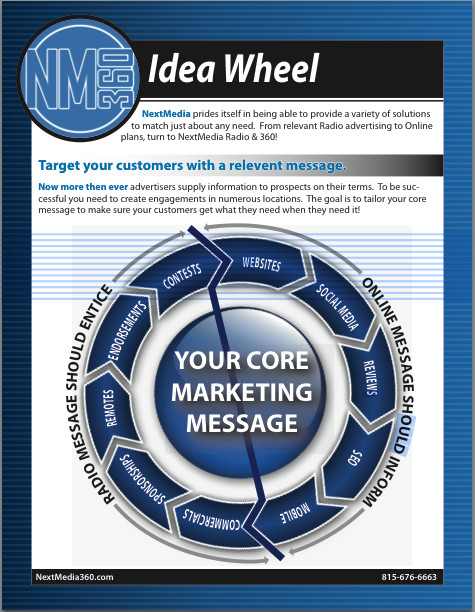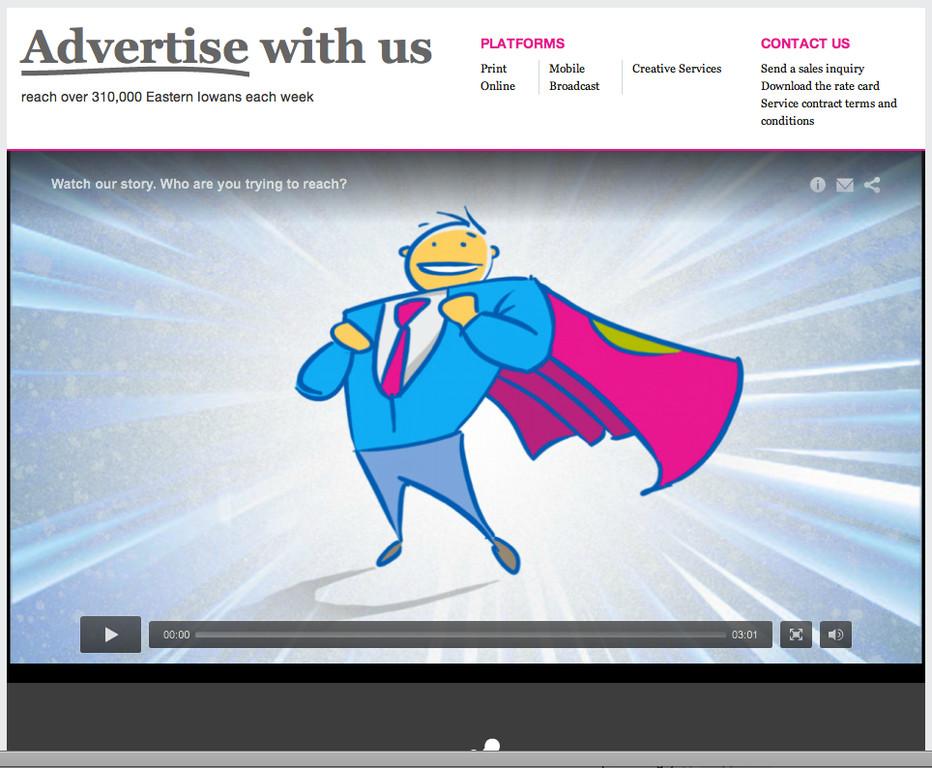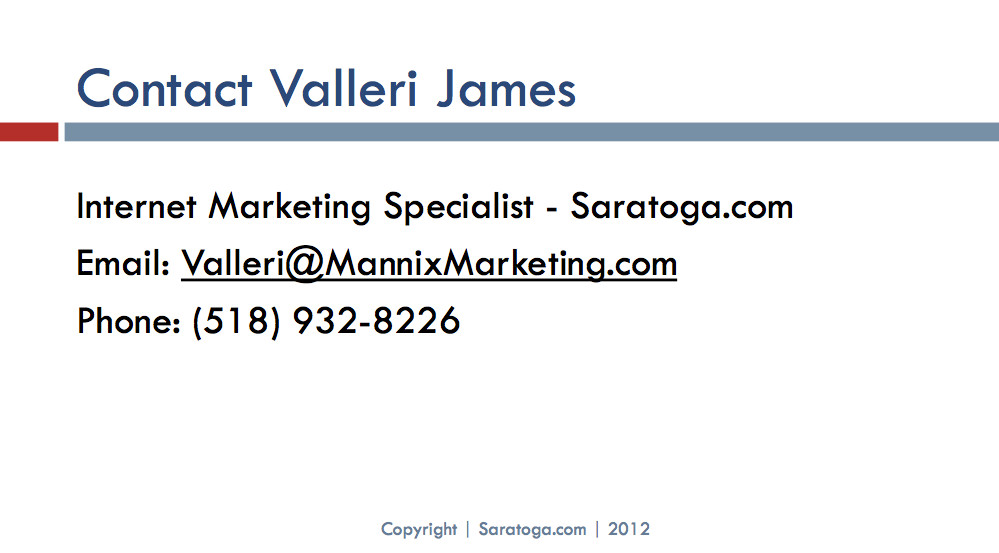Best Practices for Digital Media Kits with samples from around the country
Thinking of redesigning or just improving your media kit? Use these samples from 17 media kits from radio, TV, Pure Play, and print.
A media kit is a sales tool. Over the years, media kits have evolved from printed sheets in folders to flip books shown on tablets.
Meanwhile, the number of products, services, and packages described has exploded, making the process of creating organized, user-friendly information as much of an art as a science.
To create this report we surveyed more than 100 media kits from top local media companies to see what works. Then we collected samples that model best practices in showcasing information effectively.
A "media kit"—for these purposes—is considered the entire set of information provided to the advertiser, on- or offline, to help make the sale.
Online kits help solve new challenges. Digital kits collect data, use video to educate visitors, allow prospects to demo interactivity of rich media, and funnel prospects to self-entry order forms.
For starters, we focused on what information is digitally accessible from the "Advertise" link on the media site.
There are three competing approaches evident in this survey:
• Minimize what is published. Those who take this approach publish very little information on the "advertise" page of their site, hoping advertisers will need to call or email. Unpubliished slide decks and packages supplement kits as selling tools in the field. The "advertise" page might include only the phone number. Most publishers we surveyed—but not all—witheld at least pricing from online kits.
• Collect and organize all the data. This strategy neatly organizes all the information advertisers and sales representative need into a navigable Media Kit site, including lists of packages with pricing. Top broadcast sites often posted long lists of visually described digital products and services.
• Funnel sales. The most web savvy—and ecommerce oriented—sites incorporate best practices of online ordering sales funnels into the media kit. They use the kit not just to provide information but to whet the marketer's appetite with benefits and video testimonials, and take the marketer to a Call to Action (CTA) or even check-out page. Typically, this strategy leaves out any information that is is not essential to prompting the CTA.
Most kits were some combination of these strategies.
A. SEVEN KEY ELEMENTS OF EFFECTIVE KITS
Kits selected as samples below exemplify one or more of seven key elements of successful media kits:
1. Intelligent branding - The media kits incorporated brand elements such as font, color, look, and feel consistent with their print/on-air brands, unless they intentionally rebranded as a digital service. Samples included are from Metro Silicon Valley, KSOK radio (PDF below this article) and SanJose.com.2. Effective Positioning - The kits sold the audience strengths quickly and right up front—on the home page of the media kit site or the first pages of the PowerPoint or PDF. The most effective positioning includes digital and ranks penetration and share-of-audience in comparison with competitors in their DMA. Included are samples from the E. W. Scripps-owned WCPO Channel 9, Richmond Media Group's political media kit, and Tulsa World.
Samples from kits that position media specifically to sell digital expertise are from Idea Lab, NM360 (PDF below article), and Source Media Group.
3. Well-organized presentation – The media kits made it easy for users to find what they needed for an informed advertising decision. We looked for simple solutions to navigability, such as online kits that broke out "products" into their own category, with links to each product detail page or brochure. Included are samples from CristaBroadcasting, SuperMedia.com, the Tulsa World, E. W. Scripps-owned WCPO Channel 9, and Saratoga.com (PDF below) for a variety of approaches.
4. Essential information - The most effective media kits felt complete; they include all the information needed to buy, such as:
*Audience reach and demographics - see Orange County Register's info graphics
*Market
*Products
*Specifications
*Pricing and packaging
*Event sponsorships and/or calendars - Metro Silicon Valley
*Testimonials - SanJose.com
* Contact information
Complete PDF-style kits are CBS-Local-Media's KMVQ and Saratoga.com (attached).
5. Prominent placement of contact information and calls to action - CTAs are on all pages and placed in visually significant ways. This included not only phone numbers, but prominent data collection forms or names and head shots of sales staff for that product. Included are samples from The Tulsa World, The Idealab, and SuperMedia.com.
6. Quality visuals of digital products and services – Rather than a one-page products page, the best media kits devoted at least one page to each digital product. See Crista Broadcasting, News10 ABC, WCPO Channel9, The Idea Lab, SanJose.com, and Impact Engine's white label demo.
7. Simple packages and bundles of digital services - In addition to a la carte items, these kits also packaged media together in clearly defined bundles of products. See Crista Broadcasting, Richmond Meda Group, and PennysaverUSA, showcased below.
In general, TV sites, directories, and Pure Plays did a better job of showcasing digital products in a highly visual fashion that "sold" them to the advertiser. On the other hand, some TV stations with great PDF kits available online were short on navigation, relying on long lists of slides.
Newspaper sites tended to be more navigable but often short on visuals, and sometimes became so large and convoluted they were virtually unusable.
Directory sites, catering to large numbers of smaller merchants, were ahead of the game in packaging simple multimedia bundles and incorporating self-serve options.
B. SAMPLES FROM MEDIA KITS
To illustrate these points, here are respresentative samples from media kits that "made the cut" by exemplifying at least one of the seven key elements, and exemplifying the best new trends:
1. Branding plus data collection - Metro Silicon Valley
Metro Silicon Valley's digital kit has effective branding and visualization of specific audiences. Small media companies are sometimes better at creating effective online media kits because the job is simpler: just a few extra links on the Advertise page for information and downloads. Metroactive.com, its website, takes it one step further by including a data collection form, an increasingly common best practice for online sites:
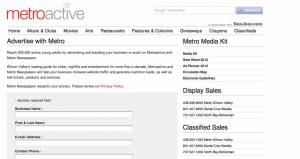
The Media kit link takes the visitor to several pages on demographics, which portray the brand effectively and position its various franchise audiences:
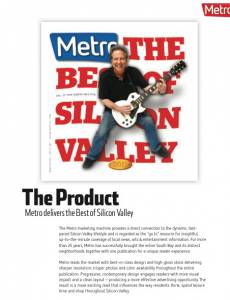
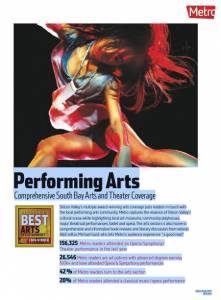
Each of its core franchises—Arts, Music, Dining, and Retail—has its own set of audience statistics with a dominant, exciting image. This kit stops short, however, of describing digital audiences and products. An easy way to grab free online audience data is via CivicScience poll, a simple code which can be placed on the site featuring poll questions that can be changed to generate data on visitors at no cost. The last page shows available event sponsorships.
Metro's kit also includes full schedule of its special issues and key dates—often asked for by agencies and an element too many kits left out. Note that key advertising dates like Labor Day and Mother's Day are indicated in a different color on the calendar:
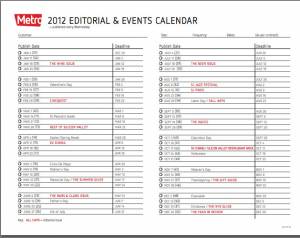
2. Branding a unique demographic - KSOK Radio
Another example of a media kit that portrays brand and positioning well is KSOK radio, below (the kit is not published online; please find the PDF below this article).
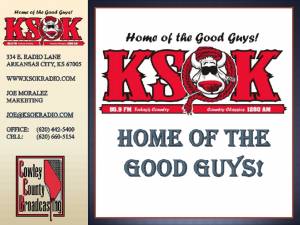
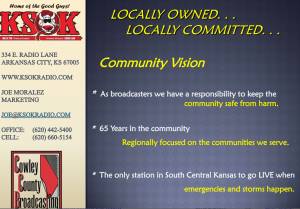
This brand is fun, but also positions the station's strength as the leading provider of emergency news. The kit also stops short of addressing digital—and leaving out an important strength. KSOK's mobile phone text alert audience, for example, is huge for a small city (case study on how they signed 50 percent of the population to text alerts is here.) Leaving out digital was all too common for many local media sites.
The media kit for city guide SanJose.com, published by the same company as Metroactive, shows how a small company can create a micro kit organized around the sales call. Shown here are a few of the sites that demonstrate how visual aids can showcase the many benefits of emerging digital products.
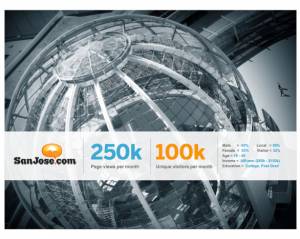
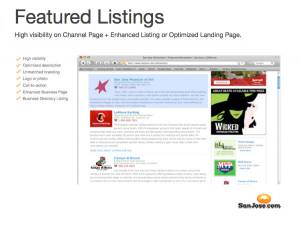
The "Optimized Landing Page" is described by this slide:
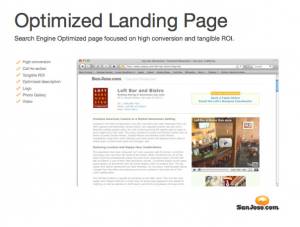
The last product illustrates display ads as "Lead generation programs" boiling the product down so that merchants can understand it easily in three steps:
1. Display advertising with special offer
2. Special offer data collection form
3. User data collect in spreadsheet
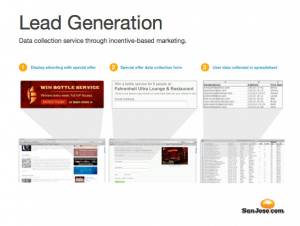
Last but not least, Sanjose.com's deck includes compelling testimonials with dollars and numbers. Testimonials can help build credibility for emerging products or reinvigorate confidence in traditional products.
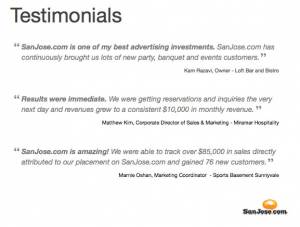
Note: A similarily-organized deck but with different products, Saratoga.com, is included in full in the images to the right (editable PDF below this article). Traditional media can learn from the simplicity and flow of these sales decks, especially for new, digital-only, sales teams.
4. Optimizing navigability - Cristabroadcasting.com
A few local news media have built truly navigable online media kits, and probably the most complete of these is CristaBroadcasting's, representing a group of four Christian radio stations. While the corporate look of this site is not visually consistent with its radio brands, the navigational elements are well worth paying attention to. That is, the navigation bar has tabs for audience, stations, on-air products (with pricing!), digital products with pricing, plus multimedia packages and the political vertical. Agencies can use the site to buy, since all of the pricing is already there. But primarily, reps use the packages in the field. Here is the front page with navigation:
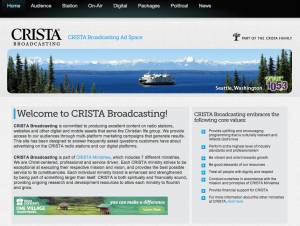
The "Audience" tab in the navigation bar links to a universal page describing the audience of a Christian radio station, common to all properties.
Another best practice on this site is separating on-air and digital products in the navigation bar, and adding multimedia packages. A user can figure out digital products and services a la carte, and then see the suggested bundles. Here's how the digital a la carte products are presented (there are six in total):
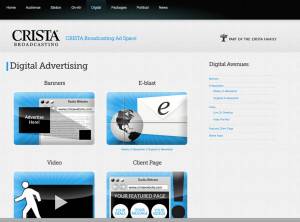
Note that an online media kit like this—as opposed to a downloadable PDF—has the advantage of interactivity: Audio and videos can be played. Rich media ads can be demoed. The "On-Air" tab even has a click-to-play audio demo.
Visitors who click on the icon for "Web Banners" for example, find a page (below) with sizes, definition of key terms, and a clickable gallery of how each looks on all four stations. Pricing charts are included as the visitor scrolls down.
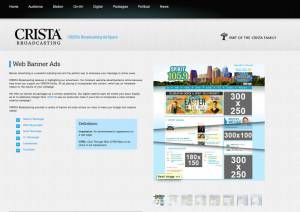
Useful definitions of key terms help merchants to understand the terminology being used on the page. The large icon links makes the navigation more visual. Unashamed of their pricing, Crista shows it for every product they sell.
Finally, reps can take tablets into the field and access the "Packages" link to show multimedia deals and sponsorships that are available, related to the stations content, upcoming events and so on.
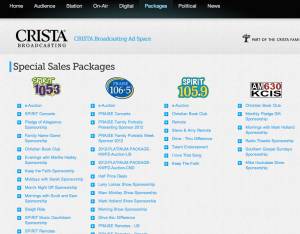
For sales reps, having packages published online is easier to use in the field on a tablet than are documents stored on an intranet that require printing multiple PDFs (and predicting which ones the advertiser will want to see) before going on a call.
There are still some additional take-outs not posted on the centralized media kit site, including these good-looking infographics showing Web and Facebook data (thanks to digital sales expert Channah Hamberg for showing us how this is done!):
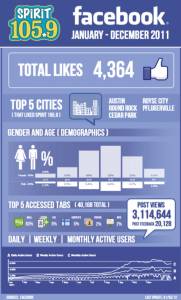
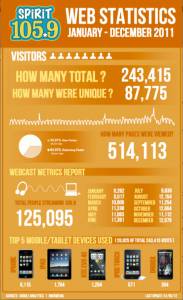
The only other news media site we found that published a variety of packages online is Canadian SunProvince.com, which also has a fully navigational site. Find the sales packages for numerous verticals are called "Media-Kits" listed here.
Companies looking for ways to present demographics for special audiences to agencies may also want to look at how Clear Channel's national ad network's full navigable online media kit. PremiereNetwork slices and dices its data in its online kit. Audio samples of its personality brands combine with an ability to choose programming/products by demographics.
4. Navigable kits - The Tulsa World
Another true, navigable online media kit was created by newspaper company the Tulsa World. Of note is the central positioning statement, as well as secondary messages ("We have the largest audience in the area" etc.) on the home page.
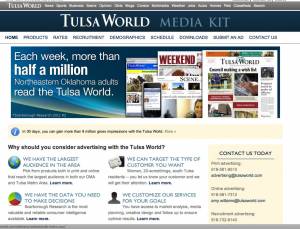
Clicking on the "Demographics" link in the nav bar leads the visitor to additional comparative positioning of its audiences: "Tulsa World reaches 53% of adults in the Tulsa DMA" compared to "a prime time spot of each of the four television stations" that only reaches 17%. A yellow color block with contact information stays on every page. This was the most one of the most prominent displays of contact phone numbers we saw on any site.
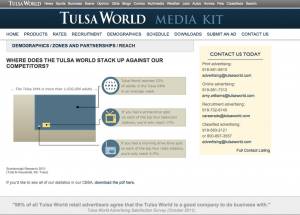
In this case the navigation includes products, rates, demographics, schedule, downloads, and submit an ad. Clicking on the Products link takes the visitor to a page with a secondary navigation for all products in the left rail.
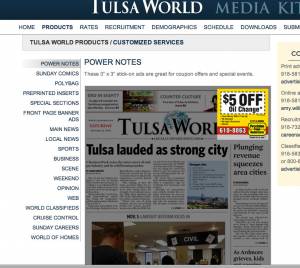
As with many print-based products, this kit does not go far enough in displaying digital options. Digital is just one tab—"Web"—in the suite of offerings. Best practice is to split print product and digital products so that digital can have its own set of product links, or better yet, its own tab in the navigation bar.
5. Collect leads and simplify products - PennysaverUSA
The PennysaverUSA has a kit that is simple and makes sense. Every page starts an offer to "Place a Free Ad," something that yellow page sites have started to do to collect merchant data or lead smaller advertisers directly into a self-serve funnel:

On the advertiser page, the visitor has two options: A downloadable PDF of the Print Products Media Kit and one for the Digital Products Media kit.
The Digital Products Media Kit starts with a cover page, list of products, and a page on each product:
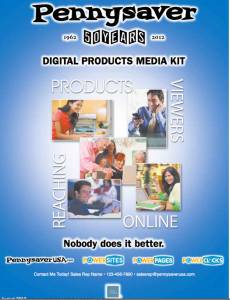
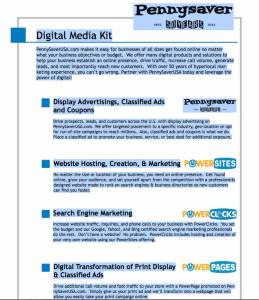
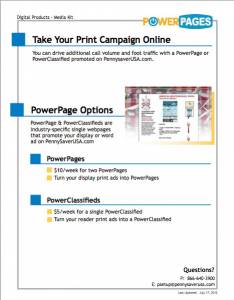
What could be simpler? For a company with hundreds of markets and mostly small business sales, this is a great solution: Five basic products, consistently priced. Note to media companies with large numbers of multiple markets: Creating a few consistent packages for the low end of the market will make buying and selling simpler and allow for a more consistent set of metrics. Why not create a digital media kit for these?
For media companies dealing with a la carte buys as well as large and small packages, it is important to break these out in the online media kit. That is, the media kit can have one navigation links for "Products" (a la carte), "Packages" (larger multi-media packages), and "Digital Starter Services" (small bundles of that include services similar to the PennySaver).
6. Visualize the product suite - News10.net, an ABC affiliate
Media kits designed for higher-end advertisers also require skill to visualize digital products that will be part of customized multi-media campaigns. An example is the clean, consistent PowerPoint-style kit from the Gannett-owned News10 ABC in Sacramento, California. It's really too long to be used as a sales presentation, but allows sales representatives to visually show almost any digital products they may be recommending to a large client. We included numerous slides from the deck to show how to quickly and visually illustrate almost any new product:
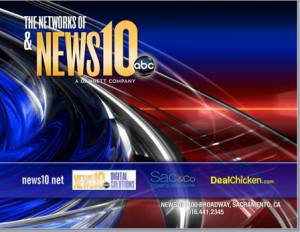
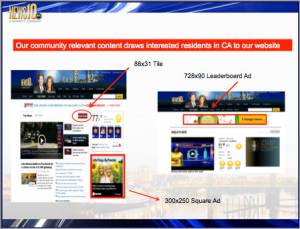
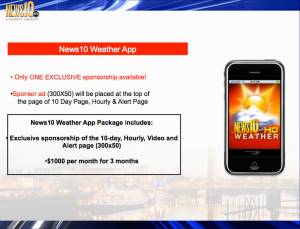
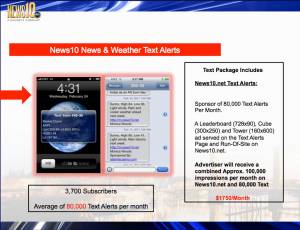
While demos of video and rich media products are preferable, News10 still does a good job of showing what these video platforms look like (Gannett has made a major investment in video content and advertising platforms so these are state-of-the-art for local media):
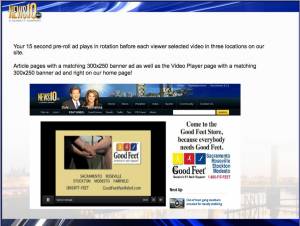
Overlays are activated by hovering and mouse-overs are indicated with arrows and screen shots:
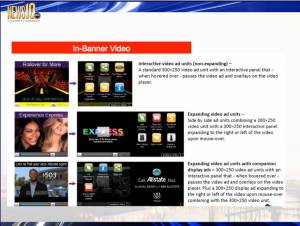
The slide on wallpaper ads gives key benefits for advertisers new to this technology:
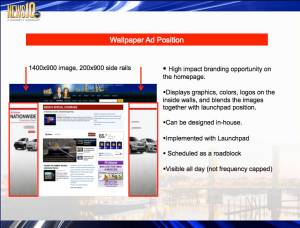
The last slide on social media is less visual (we've seen some online media kits even use "pop-up" overlays of Facebook sample pages, when visitors click on "Examples" to show what postings look like) but this gets the job done:
Finally, News10 uses several slides to explain Yahoo Behavioral Targeting:
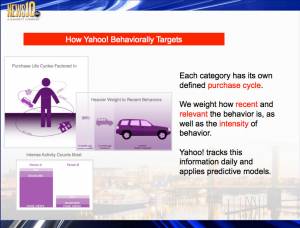
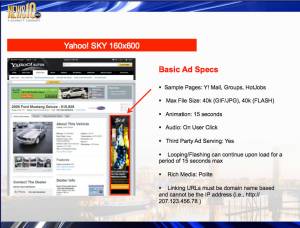
Design elements in this deck that contribute to clean presentation of numerous products include the consistent news brand on each slide, red banners in the same place on each slide with the product name, and use of arrows and red outlines. What this media kit lacks in navigability, it makes up in usefulness. Our only caveat here is that the phone number was left out!
6. Organize the "advertise page" - WCPO Channel 9
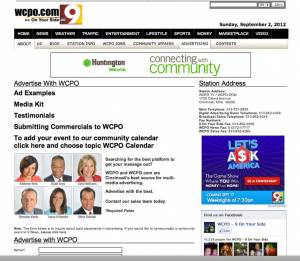
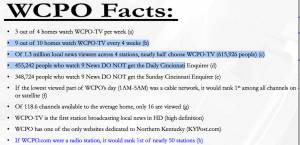
Note that this deck's positioning page includes digital, highlighted in blue: "If WCPO.com were a radio station it would rank 1st of nearly 50 stations." All local media exist in a competitve space, and the most effective positioning statements for websites in the sample were comparisons that give a sense of ranking in the market against other media or share of (in comparison to) total audience reached.
A Venn diagram also shows the brand's total unduplicated audience, demonstrating market dominance and planting the seed that advertisers will miss audiences if they don't buy multiple products.

Another way to illustrate the station's digital chops—and need for multimedia buys—is a slide depicting WCPO online as a digital media company "powered by" its broadcast news team:
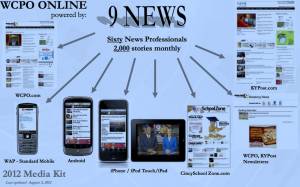
The deck includes many of the same products as News10.net, but of special note is how it visualizes targeting capabilities with a separate slide for each type of targeting, behaviorial, contextual, retargeting, geotargeting, etc.:
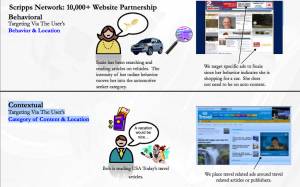
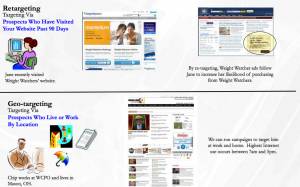
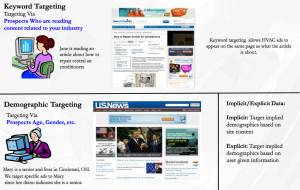
Finally, the Scripps kit shows all the partners included in the targeting—a visual we think illustrates the power of buying in a network:
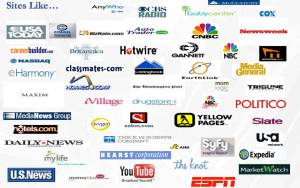
The only suggestion we have to improve organization of television media kits is to create a (short) set of links for just "Digital Products." Agencies or marketers who want to view these products online would then be able to do so more easily.
7. Multi-property solutions - Orange County Register Communications
Unlike television sites, the kits for newspapers are more navigable but increasingly unwieldly. Freedom Communication's Orange County Register Communications has done a great job of showcasing audience statistics on its web site in colorful infographics. Its centralized media kit also shows some of the new strategies, and pitfalls, of attempting to create a centralized media kit for multiple properties. The company owns, in the same market, a major daily newspaper, a Hispanic paper, a group of community weeklies, two major websites, and a magazine.
The media kit's homepage navigation bar allows visitors to select the property first, broken into groups: print, web, magazine, community and mobile. Each entity then gets its own page, with a positioning statment and two main links, one for audience information and one for rates.
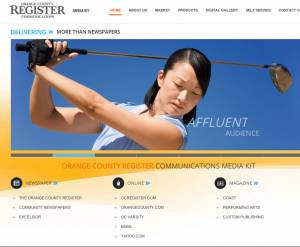
Here is an example of a property page of OCRegister.com, with its positioning statement up front, and links to Rate Card and Audience infographic on the lower left:
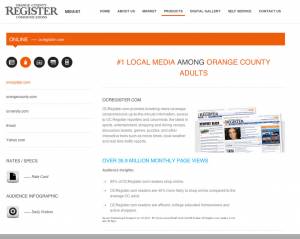
Ocregister.com also does a great job of creating website audience stats using colorful infographics and Scarbourough data (the link to full infographic is here):
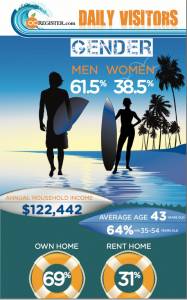
Unfortunately, this universal media kit stops well-short of greatness. An agency can find basic rates, specs, and audience data. But the kit is not organized for a local merchant or a rep to use in the field. Digital products are not well described and visuals are sometimes illegible (there is a one-page rate card with all products listed in tiny print).
Contact numbers are available only at the bottom of the rate card PDF but not on every page and some of the navigation is annoyingly duplicative (markets on the top nav takes you to the same pages as the media list on the bottom nav). The user needs to click to find addtional information, typically getting further lost. Instead they should be prompted to call and/or email.
More importantly, the kit does not address how to ebuy multiple distribution channels for a single audience—print, online, and mobile.
8. Unique agency with separate branding - Palm Beach Post's Idealab
A number of media are rebranding their sales arm—or a different wing of the company—as agencies to reflect new suites of services and expertise in creating custom multi-media campaigns. Palm Beach Post's media kit for The Idealab exemplifies this approach. In addition to the traditional media kit, it also has one for its creative services department that builds and fullfills custom multi-media campaigns (this would solve part of OCRegister's media kit issue, above, by funneling multi-media buyers to one place):
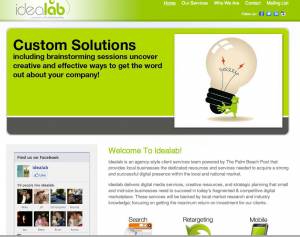
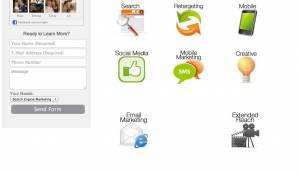
The home page of the kit gives the core value proposition: Free creative brainstorming sessions to choose the best campaign concepts.
All the digital media services that can be added to advertising to create integrated multi-media marketing campaigns are also display on the home page as colorful icons, instead of a traditional nav bar. Clicking takes visitors to to a full page about how each product or service works.
A few media have also created separate media kits for lucrative verticals, such as Political Ads, for which large buys worth thousands of dollars in a week or on a day, need to be packaged and made easy to buy.
Richmond Media Group's 2012 political media kit is a great example (find a full case study on Richmond's overall strategy: How to Double Political Ad Revenues here. Go directly to Richmond Media Group's online kit here). The kit includes everything from audience statistics to suggested packages.
Knowing they would be competing with television for political dollars, Richmond Media Group focused on making the kit highly visual, easy to read, and simple to buy. The first pages are positioned against TV and radio. Audience data is condensed on simple formats. Here's one page from the flip-book-style media kit:
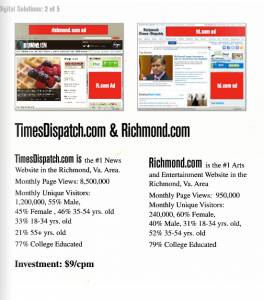
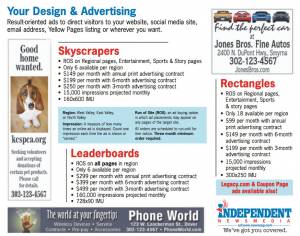
10. Personalization - Impact Engine's personalized demo site
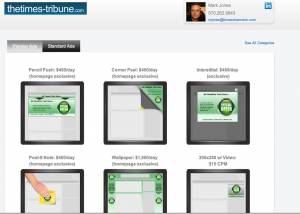
There are tabs for both standard ads and rich media ads. Sales reps don't need to wait for their company to update their media kits to accomodate rich media demos—they can just use or link to this page. Impact Engine's ad-building platform is simple to use by standard production staff, and the charge for a rich media ad is $2 to $3 CPM with a suggested retail price of $20 to 25.
C. CONCLUSIONS
There should be a number of ideas in this report to give your digital media kits a visual facelift or to add missing elements such as testimonials, packaging, and prominent phone numbers and email forms. Some local media we contacted are starting over from scratch, but overall, the research across more than 50 web sites showed that kits are not in very good shape. Typical observations:
• Advertising prices and multi-media packages options were unpublished.
• The most common form of digital media kit was still a single set of PDFs.
- PDF kits from several small sites diminished their brands with too many colors and fonts with a resulting cartoon effect that was neither persuasive nor attractive.
- Many kits simply left out information on digital products and services.
- News sites—as opposed to yellow page sites or PennySaver—did not show packages that make sense for small merchants who represent new market share.
• Digital audience data was rare.
- Many large newspaper media kit sites seemed hampered by rate and product complexity, creating duplicative navigation systems with no clear path for visitors to find what they needed or get back to a contact number.
- Phone contact information was missing completely from the site.
Positive trends are show industry leaders taking the following steps:
- Posting navigable media kits online, even if only lists of links with email forms.
- Showcasing clear visuals of digital products. Useful digital definitions and key benefits enhanced some product information.
- Providing digital audience data, including Facebook, to showcase the use of infographics.
- Displaying different audiences interactively, with a variety of targeting options. We saw audiences profiled by product type (digital, on-air, email); targeted category (homeowners, sports fans, art appreciation); and by more traditional breakdowns of age, education, gender, marital status, and income of the overall audience.
- Combinations of navigable media kit sites, with downloadable PDFs, and additional sales take outs to meet different needs.
- Published lists of packages online reps can access on tablets in the field.
- Interactive demos of audio, video, and rich-media ads included in online media kits.
- Click-to-play galleries to show examples of actual audio or video campaigns created by the media.
-
Forms and call-tracking used to acquire new advertiser data.
- Simple turnkey packages for multimedia services for small businesses.
- Digital media kits merging with self-serve ad-buying funnels.
- Free listings and specials advertised on the media kit.
- Video explanations and/or testimonials.
• Agency-style and "360" branded media kits showcase custom multi-media marketing services.
The most helpful way to organize a media kit is to start off by profiling who the advertiser is, small or large, and how they will use the information. Another step is to gather all the materials that sales reps actually use and to ask them what else they need. Have a strategy for what information should be navigable or downloadable or both, and which would be available only to sales reps via a private URL or intranet. Make sure there is also a CTA placement strategy. For example, even after a page showing audience data for moms, the kit's message might be "Call to discover packages that reach 95 percent of all Moms."
See also "20 tips for creating a great digital media kit" informed by best practices from this project.
D. MEDIA KIT LINKS BY INDUSTRY TYPE
Below are links to the kits mentioned, organized by media type:
Radio: Crista Broadcasting; KSOK Radio (included as a PDF below); Next Radio (first three images to the right); Clear Channel's Premiere Network
Pure Play: SanJose.com; Saratoga.com (PDFf kit below)
Print: Palm Beach Post's The Idealab; Metro Silicon Valley; Richmond Media Group's online kit and political media kit; Tulsa World; Orange County Register; Pioneer Press's Twincities.com
Other: Impact Engine's white-labeled rich-media demo site, personalized for each sale.
Many thanks to all the media executives who shared kits with us.

